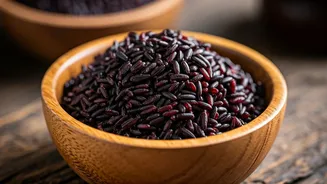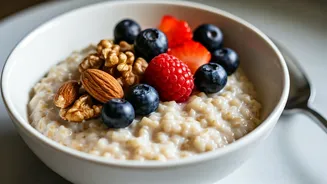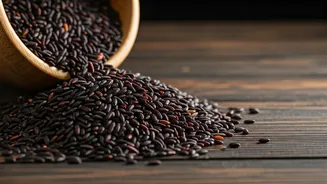Makhana: The Fox Nut
Makhana, also recognized as fox nuts or lotus seeds, is a popular snack enjoyed across India. These puffed seeds are derived from the Euryale ferox plant,
a type of water lily. Makhana are renowned for their nutritional value and are often incorporated into various dishes, ranging from savory snacks to sweet desserts. They offer a good source of several nutrients, including carbohydrates, protein, fiber, and essential minerals like calcium, magnesium, and iron. Makhana has a low glycemic index, making them a suitable option for individuals aiming to regulate blood sugar. Additionally, their fiber content aids in digestion and promotes a feeling of fullness, which can support weight management. The versatility of makhana allows them to be dry-roasted, popped, or incorporated into curries and sweets, providing a nutritious and adaptable addition to any diet. This adaptability and nutritional profile has solidified makhana as a favored health food in many Indian households, appreciated for its health benefits and culinary versatility.
Singhada: Water Chestnut Wonder
Singhada, or water chestnut, is another favored ingredient, particularly during fasting periods. These aquatic tubers, also referred to as water caltrops, are recognized for their crisp texture and slightly sweet taste. Singhada is packed with essential nutrients, including carbohydrates, protein, fiber, and important minerals like potassium, manganese, and copper. It is a good source of antioxidants, that help combat free radicals in the body. Singhada boasts a low glycemic index, similar to makhana, which contributes to its suitability for individuals concerned about blood sugar regulation. Their high fiber content promotes digestive health and assists in maintaining a feeling of satiety, supporting weight management. Singhada is typically consumed raw, boiled, or roasted. They are frequently used in both sweet and savory recipes, including halwa, vegetable curries, and as a component in various fasting foods. The versatility and nutritional profile of singhada have made it a valuable food choice, especially during religious observances and for those seeking nutritious dietary options.
Digestion: Comparing the Two
Both makhana and singhada are beneficial for digestion, albeit through different mechanisms. Makhana’s high fiber content promotes regularity, helping to prevent constipation and supporting healthy bowel movements. Fiber also feeds beneficial gut bacteria, contributing to a balanced gut microbiome. Similarly, singhada provides dietary fiber that facilitates smooth digestion and enhances gut health. Moreover, singhada contains resistant starch, which behaves like fiber by resisting digestion in the small intestine, and then being fermented by gut bacteria in the colon, also promoting gut health. Considering their fiber content, both makhana and singhada can improve digestion; however, individual tolerance may vary. Some people might find makhana easier to digest due to its lighter texture, while others may prefer singhada. When incorporating either into your diet, it’s advisable to start with small portions to observe how your body reacts and to choose the option that best fits your digestive needs and preferences.
Weight Loss: Nutritional Breakdown
Makhana and singhada are valuable additions to a weight loss plan due to their nutritional profiles. Makhana is low in calories and fat, making it a filling snack without significantly contributing to daily calorie intake. Its high fiber content contributes to satiety, helping reduce overall calorie consumption by curbing hunger and preventing overeating. The protein content also plays a vital role in maintaining muscle mass during weight loss. Singhada is also a good option for weight management as it's low in calories and rich in nutrients, including fiber. The fiber in singhada, similar to makhana, promotes fullness, leading to reduced calorie intake. Its high water content adds bulk to the diet, and the presence of resistant starch aids in the management of appetite. Both makhana and singhada can be included in a weight-loss diet, as part of a balanced and calorie-controlled eating plan that helps in creating a calorie deficit, which is essential for successful weight loss. The optimal choice depends on personal preferences and dietary needs.
Blood Sugar: Comparing Effects
Both makhana and singhada can be beneficial for blood sugar management, as they have a low glycemic index. This means they release glucose into the bloodstream slowly, preventing significant spikes in blood sugar levels. This is especially advantageous for individuals with diabetes or those looking to control their blood sugar levels. Makhana, with its low glycemic index, can help maintain stable blood sugar levels, reducing the risk of sudden fluctuations. The fiber content in makhana further aids in slowing down the absorption of glucose, contributing to better blood sugar control. Singhada also has a low glycemic index, making it suitable for blood sugar management. Its fiber and resistant starch content help moderate the release of glucose, providing more stable blood sugar levels. However, it's essential to consume both makhana and singhada in moderation. Consulting a healthcare professional or a registered dietitian for personalized guidance on incorporating these foods into a diabetes management plan is highly advisable.
Making the Right Choice
Deciding between makhana and singhada depends on individual needs and preferences. If you're looking for a low-calorie, fiber-rich snack that’s versatile in the kitchen, makhana is a great choice. Its mild flavor makes it adaptable to various recipes. If you want a slightly sweeter snack that’s also packed with nutrients, singhada is a good option. Singhada can be particularly appealing if you enjoy fresh, crunchy textures. Both options support good digestion, weight management, and blood sugar control. Consider your dietary goals, taste preferences, and any specific health concerns. Try experimenting with both makhana and singhada to see which aligns best with your dietary needs and lifestyle. You can also incorporate both into your diet to benefit from their combined nutritional advantages. Remember to consume these foods as part of a balanced diet and consult with a healthcare professional or a registered dietitian to determine the optimal choice for your health.














